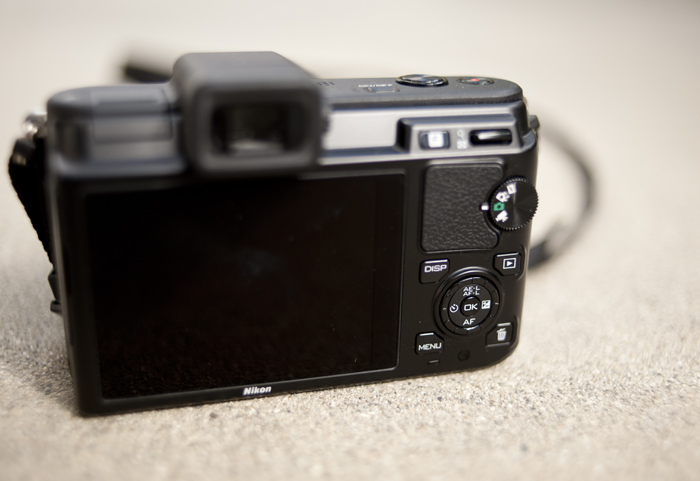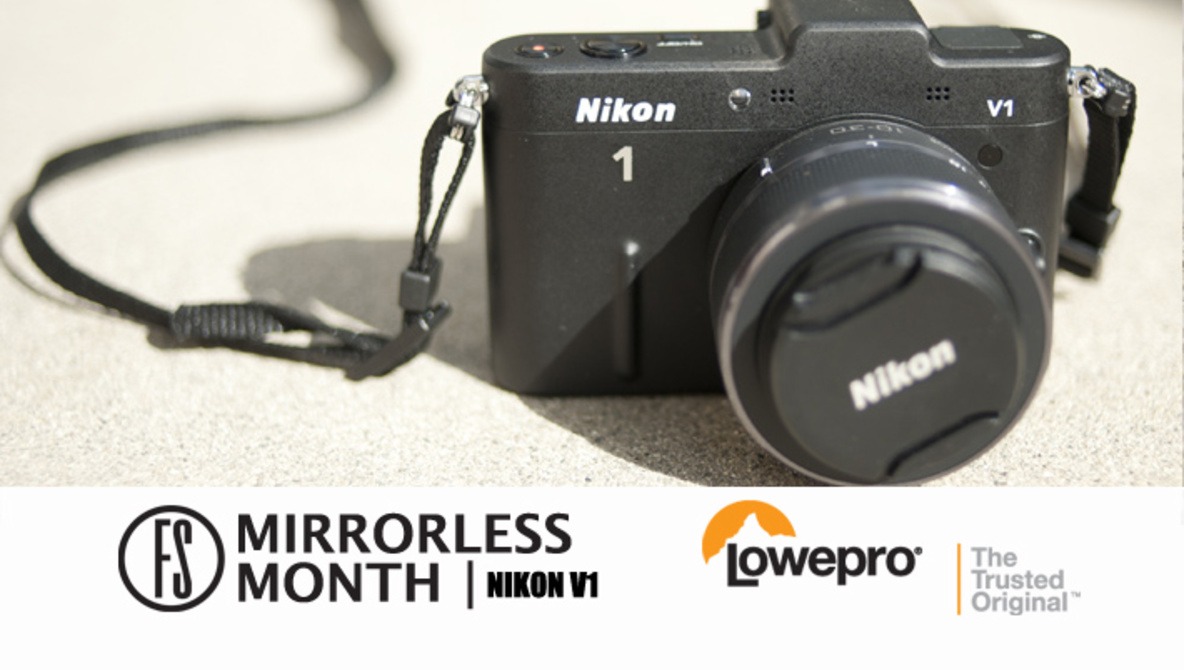Nikon is one of the big names in the camera business. And they do have some competitors in the mirrorless market: the 1 series V1 and J1. We’ll be reviewing the V1, as it’s priced and featured as a more ‘professional’ or ‘prosumer’ line and will provide us results from the best of what Nikon now offers in the mirrorless market.
Let me first say that my first impression was a good one. I like using the V1, and it feels quite solid. However, I have some serious qualms with this camera. This is mostly, however, because Nikon isn’t going for DSLR shooters that want a small camera to carry around without losing much of the functionality of a DSLR.
Instead, this camera is for the average or hobbyist consumer that loves to take pictures on vacation, on hikes around home, or whenever the family visits, and thus wants to step up to the next level, but is still scared of a full-fledged DSLR. And for this, the V1 is perhaps a perfect camera. So please keep this in mind when reading the review.
Also, keep in mind that the J1 uses the same sensor and thus has the same image quality as the V1. So if you're looking to save a bit of money, you'll lose some 'pro' features, but you might be able to live with those... That said, the price difference isn't that big these days, coming in at around $50.
The Good Stuff:
The Nikon 1 V1 has a great build. It’s square, with rounded edges, like many of the other competitors’ camera forms, yet it still feels incredibly solid. That’s likely due to its size and the full aluminum/magnesium alloy construction.
The best thing about the entire camera is the inclusion of phase-detection autofocusing. Other manufacturers are just now getting around to including this in their mirrorless cameras, but it’s a huge advantage that increases both the speed and accuracy of AF, especially in low light -- and it shows. Autofocus during video shooting is possible and very decent, I’ve found.
Additionally, the V1 features an electronic viewfinder with an automatic eye sensor -- all in a very similar way to the Sony NEX-7 and other similar cameras that feature both an LCD screen and EVF. Both, I find, are pleasant ways to use the camera, though I’m a sucker for “eye” viewfinders, electronic or not; so that’s nice to have.

The V1 doesn’t include any built-in flash, which you might have an issue with, but you can’t say there is a lack of supported accessories. Nikon has a great ‘system chart’ on their website that lists all of the available accessories for the V1 that help make it a truly versatile camera.
In general, buttons are easily reachable and useable -- not too small, and with a good feel.
Finally, the kit lens (or lenses, depending on what you get) covers a great range that’s very convenient for walking around. The second lens, if you get the two-lens kit, picks up right where the first leaves off, adding some serious zoom capability. That said, I still prefer lenses with fixed apertures, meaning they don’t change their lowest aperture value (largest opening) based on how much you have the lens ‘zoomed in.’ This just makes shooting manually more difficult as you’re constantly having to change your setting as you zoom. This is the case with virtually any mirrorless zoom lens, however -- keep that in mind when you’re shopping for anything.
The Not-So-Good-Stuff:
First and foremost, this has a relatively small sensor. But read on in the next section for more information about that.
The body and controls that are present are great. However, there are a few things lacking. First of all, to change modes between manual, automatic, aperture-priority, shutter-priority, or program, you’ll have to go into the menu system -- there’s no shortcut. In addition, there’s no ISO button! Again, you have to go into the menu system for this, too. You should know from my previous reviews that I can’t stand that, but the lack of a shooting mode dial is an even bigger issue for me.
Instead of an Auto/M/S/A/P mode dial, Nikon chose to include a dial with various shooting styles, including still capture, movie, smart photo selector, etc. I find these unhelpful. But then this once again speaks to the consumer-heavy prosumer aspect of this camera. I have to say that when I was hiking ‘the dish’ (for those of you that might in the Palo Alto area), that mode dial constantly got knocked to different modes while hanging on my side by the shoulder strap. This was incredibly annoying, and the switch should have been made much firmer, but it shouldn’t be a main buying (or ‘not buying’) point.

The battery lasts for 350 shots. This isn't 'bad.' Most of the other competitors reviewed this month feature the same kind of battery life. However, the V1 uses the same battery as the D7000, D600, and D800 DSLRs that Nikon makes, each of which get about 900 shots on that battery. Yet the V1 barely gets a third of that? I assume that's because of the constant use of an electronic viewfinder, whether you're using the LCD or the actual EVF. But in any case, I was hoping for more from that large of a battery.
Image Quality:
The V1 produces sharp, stunning images, as do most of these high-quality mirrorless cameras today. However, it is built on a platform that leaves room for only a small sensor -- the CX mount. It’s an entirely new format that’s bigger than the 1/1.7” sensor, but also quite a bit smaller than the four-thirds sensor, let alone the much larger ASP-C format. That means less quality in the low light arena and more noise in general.
To combat this, Nikon maintained a relatively low 10MP to allow room for those pixels to be larger on the smaller chip, likely counting on people’s knowledge that 10MP was still more than they would every want to use 99.9% of the time. While 16-20MP is a sweet spot for prosumers and professionals alike, leaving room to still crop while having high-quality, large prints, 10MP is still more than enough for 99% of the world’s shooters.

Overall:
I like this camera -- I really want to like this camera. If I were an amateur or hobbyist wanting a great camera to shoot on auto, this would be it. But the truth is, I’m not. I expect a lot from my equipment. And most of all, I expect it to function quickly with all the settings that I want at my fingertips.
But in all honesty, this is a great camera at a great value. For less than $500 you get what Nikon considers its ‘pro’ mirrorless line and a lens to start you out. From there, you can add any number of accessories, like a flash or external microphone for better audio recording during video. That’s not bad. Not bad at all.









I agree with a lot of the comments above. We put together a video review last year. It's a bit dated as we comment on the price which has come down quite a bit but there's a lot of good info, too. http://www.youtube.com/watch?v=eoaly9KdTHI
The lack of a standard hotshoe kills this for me. It means I can't use my sb700 (I know, it's huge, but whatever) or sb400 (more appropriate for the size) and it means I can't use radio triggers either for wireless. Dead in the water. The camera is no longer the only thing you buy; it's part of a system of other gear you have.
Hey this review is just in time for the Nikon V2 announcement later this week!
The review does not mention that the V1 lets you use your regualar Nikkor lenses (with a $200 converter). I use my V1 on my 70-200mm f/2.8 and, since the crop factor on this camera is 2.7x, it gives me an effective field of view as if I were using a 190mm-540mm f/2.8 lens. Great for wild life and sports since it can shoot stills at 10, 30 or 60 fps with the electrinic shutter.
You can use a lot of different lenses on a lot of different cameras with a lot of different converters. I didn't mention it because it's really not a unique feature (kind of like saying you can use a micro sd card with an adapter). Hope you understand. But yes, you can. And that's a great feature that a lot of manufacturers have allowed for....